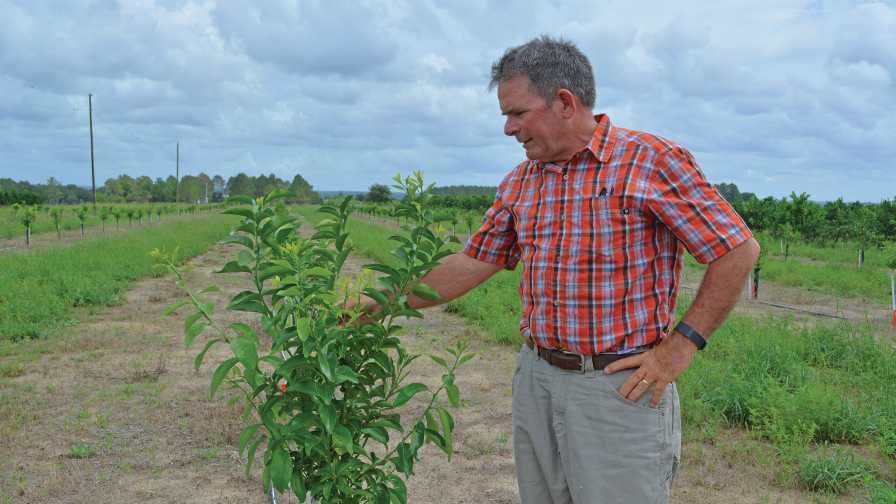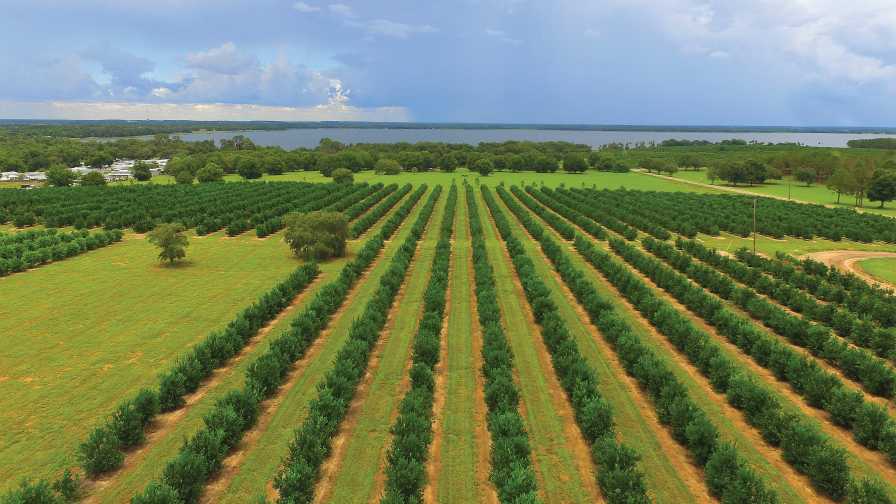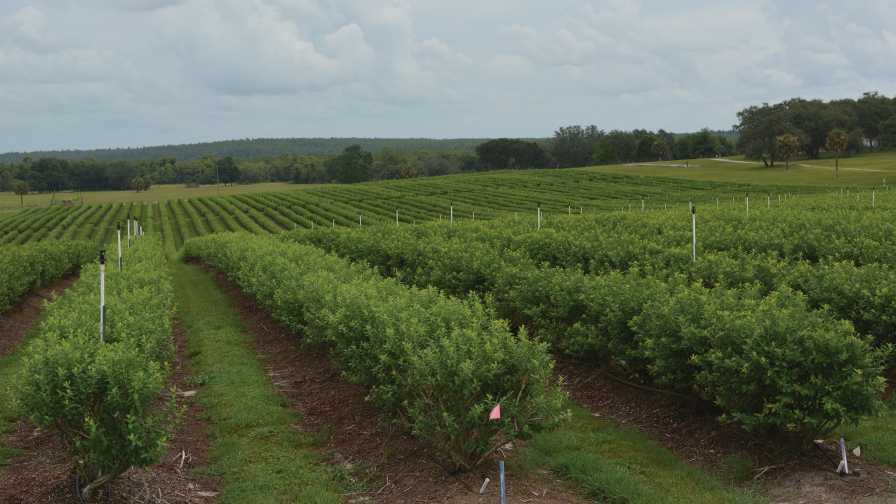Florida Farmer Takes Fresh Approach To Growing Citrus

Chuck Allison took the dive into citrus, planting 100 acres in 2012.
Photo by Frank Giles
Planting a new block of citrus in the era of HLB is not a decision to be taken lightly. And, heading into the endeavor without a lot of citrus experience makes the choice even more daunting.
But Chuck Allison, Owner of Spring Valley Farms near Umatilla, saw opportunity with the crop and took the plunge into citrus. Allison had raised cattle and hay on his property since 2004, and in 2008, planted blueberries on his farm as that market was heating up, followed by citrus in 2012.
Prior to farming, he had worked at Duda Farm Fresh Foods as a Manager of Business Analysis and then another 23 years for Prudential, working his way up to National Director for Agricultural Investments for the company. He says working with both companies taught him the value of building a great team of employees and learning from other successful farms.
“Working with a family like the Dudas, I got to learn about their morals and good business practices,” he says. “And, working with Prudential, I got to see all facets of agriculture. Both were wonderful experiences and helped teach me how successful farmers operate all over the country.”
Allison put that knowledge to work when he planted blueberries. He established a marketing relationship with Wish Farms a couple years after the planting and built a packing facility on the farm.
“Wish Farms does an excellent job with blueberry marketing due to their year-round presence and customer profile,” Allison says. “We have expanded the packinghouse to pack our own berries and other local growers.”
Tasty Tangos
With a few years of blueberry growing under his belt, Allison decided to investigate planting citrus. He began asking questions about managing citrus in the midst of HLB from growers and researchers. He investigated which varieties would provide the best economic returns. He zeroed in on ‘Tango,’ ‘Early Pride,’ and navels. “Tango” comprises most of the 100 acres. It is an easy-peel, seedless mandarin.
“Through my work with Prudential, I was able to see what California growers had been doing with ‘Cuties’ and ‘Halos’ and how profitable the tangerines and clementines had been,” Allison says. “The ‘Tango’ is a high-value, fantastic piece of fruit.”

The ‘Tango’ has superior interior quality and brix.
Photo by Frank Giles
Allison says ‘Halos’ and ‘Cuties’ have established a strong market and consumer demand and will help pave the way for an East Coast easy-peel, seedless mandarin. And, market windows don’t overlap too much, giving room for success. Most California fruit comes in after January. Chile fruit comes in ahead of Florida.
“If we can hit the October through December window when there is not a large volume of mandarins on the worldwide market, Florida has an opportunity to find a spot in that window, if we can find the right varieties,” he says.
Beyond the market window, Allison also likes the earliness of ‘Tango’ because his planting is so far north (right on the southern edge of the Ocala National Forest). ‘Tangos’ will come off the trees before the coldest months of winter. One challenge with the variety is it doesn’t color up well. He hopes being further north will provide the necessary chill hours to color the fruit in the November and December timeframe.
“The consumer wants something they can consume easily — something the kids in the backseat of the car can easily peel and eat,” Allison says. “Think about Florida fruit, which has much better internal quality, brix, and flavor when compared to California.
“If we can find the right varieties, the right fruit for consumer demand, and the right market window, we will have something special. That is why the FAST TRACK program to establish these varieties is so critical.”
Peter Chaires, Executive Director of the New Varieties Development & Management Corp. (NVDMC) says Allison is finding success with these high-value specialty varieties.
“Chuck is always current on the latest information on rootstocks and rootstock/scion combinations, as well as horticultural practices,” Chaires says. “He’s methodically innovative, which is a rare combination.
“Chuck also is registered to plant several of the most promising experimental FAST TRACK fresh citrus selections, made available through a cooperative program between NVDMC, UF/IFAS, and Florida Foundation Seed Producers Inc. If any of these selections prove commercially viable, he will be in a position for rapid expansion and early market penetration. Despite the many positive advances on the disease front, we have fewer growers every week with the resources to replant. It is tremendously beneficial to have growers like Chuck who are feeding supply while helping to identify the varieties that will help jumpstart Florida’s citrus recovery.”

For Spring Valley Farms, being located south of a lake and high on a hill with good soil was a critical factor to planting citrus so far north in Florida.
Photo courtesy of Chuck Allison
Planting To Micro-Manage
According to Allison, managing the farm’s 120 acres of blueberries was good preparation for managing citrus in the era of HLB.
“In blueberries, we are out in the field every week doing something to the plants with either people or machinery,” he says. “It is a very intensive crop, and we were comfortable bringing that mentality into the citrus planting.”
In addition, Allison says he relied on the expertise of UF/IFAS and the knowledge of other growers in preparation to plant citrus. He also credits his farm team — his wife Vesna, Production Manager Nato Martinez, Office Manager Terri Martinez, and Strategic Business Analyst Travis Kuhn. In addition, Wes Mathis consults with the team on citrus production decisions.
“We don’t claim to have all the answers and we are still learning from our own experiences and from the help of others,” he says.
The grove was planted with 220 trees per acre (9 feet by 22 feet). The higher density and an aggressive fertilizer program aims at moving trees into production more quickly. This past season, at three years old, the Tangos yielded their first crop of 160 boxes per acre. And, a good crop appears set for next season.
Allison has placed a big emphasis on managing an intensive fertility program. At planting and in the early years of tree development, slow-release fertilizer has been applied. While it is more expensive, Allison says the young trees benefit from having the steady release of nutrients.
“I believe the slow-release fertilizer really helped these trees grow and get established much faster,” he says. “We used different brands, but we like the ones that are homogenous with both the minor and major elements coated because you get every element slow-release rather than just some.”
Foliar fertilizer applications also have been critical in getting trees off to a fast start.
“Every time we go through the grove, we are feeding the trees,” he says. “And, we are going through at least every five weeks. We are applying foliar fertilizer in all those trips, except in the winter.”
Trees also are receiving some fertigation. As the trees get older, Allison will shift away from slow-release fertilizer and move toward a more regular fertigation regime.
“It is important to keep these roots fed on a much more frequent basis than what we were accustomed to before HLB where we were putting out dry fertilizer three or four times per year,” he says. “With a good fertigation system, we can efficiently fertilize the grove at much higher frequency. The purpose is keeping these trees fed all the time.”
Allison uses soil moisture probes in his blueberry and citrus plantings to monitor the demand for irrigation. In citrus, Ranch Systems weather stations come equipped with moisture monitors. Soil probes from High Yield Ag also are utilized in the grove.
The probes have moisture sensors every 8 to 12 inches and allow him to monitor water levels down to about 4 feet into the soil profile. The sensors also have salt index readings, which provide a barometer for where the fertilizer is located in the root zones. The probes help them manage soil moisture levels and avoid pushing nutrients below the root zone.
“The High Yield Ag probe allows you to transmit its data onto your smartphone, so you can keep track of what is going on in the grove,” Allison says. “We have a general sense of where we need to be in terms of the root zones based on discussions with UF/IFAS and our soil type.”
According to Allison, the incidence of HLB in the grove is about 7%. He says being somewhat isolated helps, but he also credits an aggressive scouting and psyllid control program. He currently is evaluating the impact of the recently approved bactericide applications have before determining how aggressive his infected tree removal will be.

According to Chuck Allison, the intensive nature of managing the farm’s 120 acres of blueberries prepared him well to take on HLB in citrus.
Photo by Frank Giles
Planting Forward
Going into citrus, Allison and his team planted with HLB in mind, considering marketing and micro-managing production. He says more citrus planting is planned as he learns more and if he finds new viable varieties that are currently being evaluated.
“We will plant up to 100 more acres over the next couple of years,” he says. “We just want to get a little more comfortable with HLB and get a better understanding how these newer varieties will perform and how successful they will be. We have even ordered 12 acres worth of the new ‘Bingo’ variety to evaluate it.
“We place a priority on micro-managing these trees. If we see a problem with individual trees, we have the ability to go out and spot treat them in a way that would be much more difficult if I were a larger grower.”
Giving Back
Allison understands the critical importance of the labor force that comes annually to help harvest his blueberry and citrus crops and run his packinghouse.
His wife Vesna works daily with the labor crews that total 250 to 300 workers. Before the end of the season, she knows all of them by first name.
“My wife works in the fields with the workers and it is incredible the relationships she builds with them and the mutual respect that grows out that,” he says.
At the end of the blueberry season, the farm hosts a Gleaning Festival with all the proceeds going to support the Redlands Christian Migrant Association (RCMA) and its mission to provide care and education for farmworkers’ children. More than 500 people attended the event this past season, which raised more than $26,000 for RCMA.
“In our area, RCMA has multiple centers that provide quality childcare for migrant works so both parents can work,” Allison says. “We have been able to attract and retain migrant families for many years because of this service. RCMA provides a wonderful service for these families, and we are proud to support it.”










